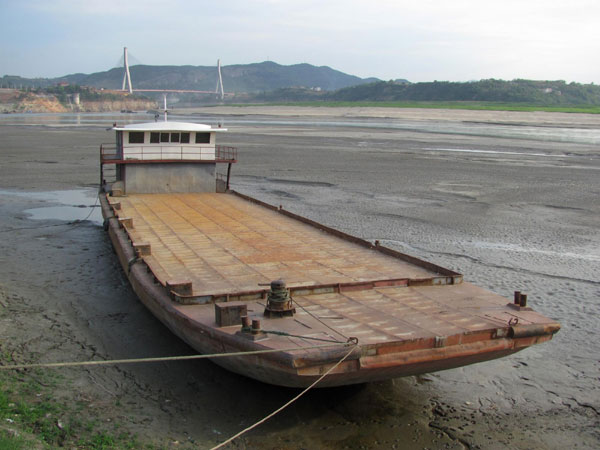Society
Drought leaves 1,400 reservoirs 'dead' in C China
(Xinhua)
Updated: 2011-05-16 16:37
 |
Large Medium Small |
 |
|
A vessel is seen stranding on the dried up riverbed of Hanjiang River in Yunxian county of Shiyan, Central China's Hubei province, May 15, 2011. [Photo/Xinhua] |
WUHAN - A lingering drought in Central China's Hubei province has rendered 1,392 reservoirs virtually useless as only dead water remains in them, said the local water authority Monday.
Known as the "land of a thousand lakes" and a major producer of grain and cotton in the country, Hubei is suffering from a drought that has lasted for five months.
As of Sunday, water in four medium-sized and 1,388 small-sized reservoirs had dropped below the allowable discharge level for irrigation and other purposes, said Yuan Junguang, director with the reservoir management office of Hubei Provincial Water Resources Department.
One fourth of all small-sized reservoirs in Hubei were unusable with just dead water remaining in them which could only be pumped for use in an emergency, he said.
The water level of the Danjiangkou Reservoir, which is part of China's massive south-to-north water diversion project, was also extremely low, measuring 134.77 meters on Saturday, 4.23 meters below its dead water level.
Also as of Saturday, the drought had left about 315,000 people and 97,300 livestock in the province short of drinking water. About 12.45 million mu (about 830,000 hectares) of farmland has been affected by the drought, according to a survey conducted by the Hubei provincial agricultural department.
"Ever since Spring Festival in February, we've had no drinking water in the village. It's now a routine for us to carry water in from about two kilometers away," says Yu Youqing, 73-year-old farmer in the village of Huashan in Hubei.
The local government has started regularly delivering water to the village using fire trucks. Although, this makes the villagers' domestic lives easier, it does not benefit their crops.
"We harvested nothing from the wheat and other core crops planted last autumn. What's worse is there's no water for the spring sowing," says Yu whose village is located on Jianghan Plain, known as the "land of fish and rice."
Jiangxi, Hunan, Guangdong, Yunnan and Sichuan provinces and Guangxi Zhuang autonomous region, all located in the south or center of the country, are also suffering from drought.
"It's already reached the standard of extreme weather. This year's drought is partly due to the weather pattern known as La Nina," says Zhou Yuehua, a meteorologist with the Hubei Provincial Meteorological Bureau.
La Nina causes lower sea surface temperatures, which in turn affects precipitation levels, Zhou explains.
"The water crisis is not because of a scarcity of water but uneven distribution of resources," says Huang Qi, head of the disaster prevention and reduction office of the Yangtze River Water Resources Committee.
A unified water conservancy system is urgently needed. The central government should build large-sized water reservoirs, while local government should take care of regional irrigation facilities, he says.
China said earlier this year it would invest 4 trillion yuan (about $154 billion) over the next 10 years to establish multi-level water conservancy facilities.
In recent years, expansive wetlands and lakes have shrunk or even disappeared in southern China. This has hindered China's ability to store and regulate water adequately, says Lu Zhongmei, water resources expert and the Hubei University of Economics.
Governments at all levels need to make more efforts to preserve the country's lakes and wetlands, says Lu.